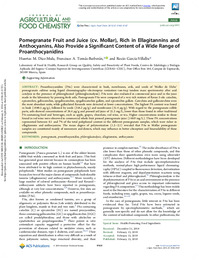Título :
Pomegranate Fruit and Juice (cv. Mollar), Rich in Ellagitannins and Anthocyanins, Also Provide a Significant Content of a Wide Range of Proanthocyanidins |
Autor :
Diaz-Mula, Huertas Maria 
Tomás-Barberán, Francisco A.
García-Villalba, Rocío |
Editor :
American Chemical Society |
Departamento:
Departamentos de la UMH::Biología Aplicada |
Fecha de publicación:
2019-02-15 |
URI :
https://hdl.handle.net/11000/31419 |
Resumen :
Proanthocyanidins (PAs) were characterized in husk, membranes, arils, and seeds of ‘Mollar de Elche’
pomegranate cultivar using liquid chromatography−electrospray ionization−ion-trap tandem mass spectrometry after acid
catalysis in the presence of phloroglucinol (phloroglucinolysis). PAs were also evaluated in commercial juice and in the juice
made in the laboratory by pressing fresh arils. Pomegranate PAs were composed of a very rich mixture of flavan-3-ols: catechin,
epicatechin, gallocatechin, epigallocatechin, epigallocatechin gallate, and epicatechin gallate. Catechins and gallocatechins were
the most abundant units, while galloylated flavanols were detected at lower concentrations. The highest PA content was found
in husk (1840.5 μg/g), followed by seeds (316.2 μg/g) and membranes (51.4 μg/g). With regard to the pomegranate edible
parts, arils showed concentrations of 34.4 μg/g and pressed aril juice of 21.3 mg/L, lower than those found in other traditional
PA-containing food and beverages, such as apple, grapes, chocolate, red wine, or tea. Higher concentrations similar to those
found in red wine were observed in commercial whole fruit pressed pomegranate juice (146.9 mg/L). These PA concentrations
represented between 0.1 and 7% of the total polyphenol content in the different pomegranate samples, which were richer in
ellagitannins and anthocyanins. The mean degree of polymerization (1.2−2.1) revealed that PAs in Mollar pomegranate
samples are constituted mainly of monomers and dimers, which may influence in better absorption and bioavailability of these
compounds.
|
Palabras clave/Materias:
pomegranate
proanthocyanidins
phloroglucinolysis
ellagitannins
anthocyanins |
Área de conocimiento :
CDU: Ciencias puras y naturales: Biología |
Tipo de documento :
info:eu-repo/semantics/article |
Derechos de acceso:
info:eu-repo/semantics/openAccess
Attribution-NonCommercial-NoDerivatives 4.0 Internacional |
DOI :
https://doi.org/10.1021/acs.jafc.8b07155 |
Publicado en:
Journal of Agricultural and Food Chemistry (2019), 67, 9160−9167 |
Aparece en las colecciones:
Artículos - Biología Aplicada
|

 La licencia se describe como: Atribución-NonComercial-NoDerivada 4.0 Internacional.
La licencia se describe como: Atribución-NonComercial-NoDerivada 4.0 Internacional.
.png)